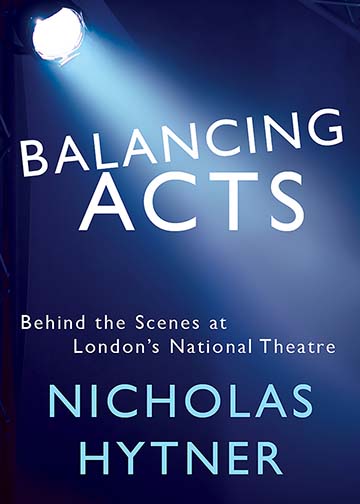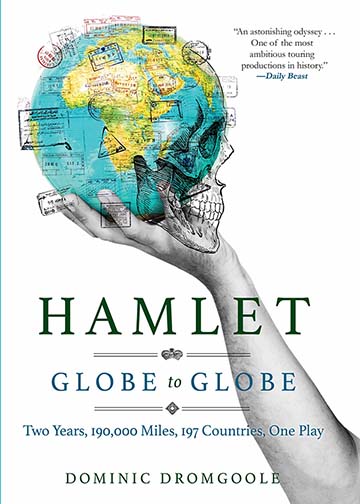Their theatres, two of London’s most prestigious, stand less than a mile apart. Nicholas Hytner and Dominic Dromgoole ran the National and the Globe, respectively, in the first decades of this century. Both filled cavernous houses by broadening their audiences. Both were risk-takers and champions of new work. And both expanded the international reach of their institutions.
Yet their pedigrees, directing styles, and agendas—as laid out in their new books, Balancing Acts and Hamlet Globe to Globe—could hardly be more dissimilar. Hytner was a wunderkind with major commercial cred (Miss Saigon) who was invited to the National Theatre as an associate by Richard Eyre. Dromgoole, known chiefly as artistic director of the Bush Theatre and Oxford Stage Company, talked his way into the Globe despite a reputation mostly for new work and a West End production of Troilus and Cressida that by his own admission was a “car crash.” Their Hamlets were on opposite ends of the spectrum of directorial license, and their memoirs reveal strikingly different professional personas.

Though written with refreshing humility, Balancing Acts makes a good case for Hytner’s reign as the most significant in the National’s history. In his first year he attracted an audience that had never imagined sitting in the Olivier with the profane and raucous Jerry Springer: The Opera, via a £10 rush ticket courtesy of Travelex. With a populist bent and a flair for showmanship, Hytner produced The History Boys, War Horse, The Curious Incident of the Dog in the Night-Time, and One Man, Two Guvnors, all West End and Broadway hits. It was under Hytner that the NT began to produce its own shows commercially instead of relying on others, and launched the wildly successful NT Live broadcasts.
Hytner left the NT in 2015 with 70 new plays on commission—quite a bequest to his successor Rufus Norris. In his final two seasons, 16 of 30 new plays were written by women. Whether it was his penchant for populist spectacles, the demands of two of the NT’s large houses, or a decline in British playwriting, most of his successful new plays were large-scale entertainments. While it’s hard to pinpoint more than a few new plays from his tenure that are sure to have lasting literary value, he was the National’s first artistic director to produce as many new works as classics.
On the pressures of helming a juggernaut, Hytner writes, “You start with a vision and deliver a compromise…We want to make art, and we know we’re in show business.” It’s a balancing act he articulates with grace and modesty. There is no mistaking, however, that as producer and director he was a consummate showman on the level of (or even a cut above) his predecessor, Trevor Nunn. More often than not, as with a definitive 1994 revival of Carousel, there was intellect and originality behind the pizzazz.
Balancing Acts opens with a few logy chapters on programming at the NT before and after his tenure. But once Hytner fastens on his fertile partnership with Alan Bennett (The History Boys and The Madness of King George III), the book gains its footing. Lunch with a hostile Harold Pinter and one with a loquacious John Gielgud provide color.
Not every artistic director hires superior guest directors, but Hytner did. And he recognized that much of his success was owed to the likes of Howard Davies, Marianne Elliott, Simon McBurney, Sam Mendes, and others. He treats them all generously, even Katie Mitchell, whose work he admired but eventually found lacking in audibility and focus.
Always on the lookout for actor vehicles, Hytner struck gold with Simon Russell Beale, James Corden, and Maggie Smith. Though John Wood “was reason enough” to direct King Lear and The Tempest, Hytner admits that his productions “suffered from a lack of specificity in their stage worlds. These days, I could not stage King Lear without making clearer choices about Lear’s kingdom, and about the systems that underpin his power as a king as well as a father.” From these experiences he came to the realization that, in terms of directorial choices, “timeless…now means insipid.”
If Hytner’s Shakespeare record at the National was patchy, his Hamlet featured its share of intriguing ideas, including the notion that Gertrude’s flower-strewn account of Ophelia’s suicide was a lie, because Claudius had had Ophelia killed. In preparation for directing the play he traveled to Berlin in 2008 to see Thomas Ostermeier’s famous Hamlet at the Schaubühne Theatre, and he was especially struck by the production’s opening dumb show of Old Hamlet’s funeral, in which Hamlet stared into the grave for what must have seemed like an eternity before falling in, then clambering out, eating mud, and by the doubling of Gertrude and Ophelia, which underscored Hamlet’s misogyny.

En route with his own Hamlet, Dromgoole also had an encounter with Ostermeier, at a café during a festival in Tbilisi. He and the “theatre-god director—possessed of a sort of Californian/Teutonic cool, with complex signifiers of status being stitched into every movement”—wrestled about their Hamlets and “were drawn into the most infantile directorial cock-off.”
It isn’t difficult to imagine what the Globe artistic director would have made of Ostermeier’s Hamlet. Dromgoole’s version was bare-bones, capable of being rolled out in a matter of a few hours from a few dozen packing cases, at venues ranging from the fascist-styled National Theatre of Ethiopia to a Middle Eastern refugee camp.
Rather than tell a chronological tale, Hamlet Globe to Globe cleverly aligns themes of the play with choice venues and remarkable tales. The play’s Christian background is decoded in a chapter where, on a Pacific island, the company happens upon an American carrying a cross on wheels around the world. Dromgoole scrutinizes the play’s violence in a chapter on performances in the killing fields of Cambodia and Vietnam; revenge underpins their Iraqi excursion; and the female production history of the play connects with the first Shakespeare performance by men and women in Saudi Arabia, at King Abdullah University of Science and Technology.
Dromgoole lays out multiple interpretations of the play’s world, describing Denmark as “as an arena of medieval brutality or an unfeeling bureaucracy; as a failing state or a reviving tyranny,” complete with “surveillance tropes.” Yet he doesn’t privilege any one interpretation. Sounding more like an English professor than a director, he offers a prescription for what Hytner would consider a muddle: “The best way to avoid a misconception is to have no conception at all.” Opening with a song and concluding with a jig, his Hamlet sounds from afar like a happy-go-lucky-let’s-put-on-a-play affair. The absence of a concept nearly always signals a production without a reason for being.
When peeved, Dromgoole asks, “Why? Well, why not?” One imagines that his real impulse was to revive the Globe’s venerable touring tradition. (The King’s Men performed out of town, though in Coventry, Cornwall, and Nottingham, not Lagos or La Paz.) Or, finally, falling back on sheer machismo: “It was to prove that it could be done.”
To his credit, Dromgoole recognizes the project’s strain of naïve good will. “Two notable delusions probably shaped the beginning of the tour,” he concedes, the first being that Hamlet is “a journey toward peace, that there is a light at the end of the tunnel,” the second amounting to a hope that touring Hamlet “would have some sort of benevolent effect, spread a little world peace, nation talking to nation, etc. Unforgivably grandiose, but true. Shame on us for our stupidity, but you need a small helping of stupidity to launch anything of this size.”
Some naysayers—“Mr. Grumpy Boots” and “Mrs. Mardy Knickers,” he calls them—attacked the project on the grounds of cultural exclusivity, while academics brandished accusations of cultural imperialism. The cost—£15,000 to get in and out of each country if even for a single performance—was apparently borne by the wealthy countries to cover the poorer countries, like Ethiopia, which proudly chipped in £55 for two performances for 4,000 people.
Yet even Ahab, Don Quixote, and Fitzcarraldo had their good days. The Hamlet tour met standing ovations in places where lives of quiet desperation were invigorated by three hours or so of free verse and swordplay. As an outreach effort, it certainly mocked what Dromgoole wryly pans as “shyly presented programs so stuffed with proof of virtue and condescending good works that mischief and fun (the motors of all good drama) hardly get a look in.”
There were compromises—at times “psychological nuance had to take a back seat to semaphoring hand movements, and textual music gave way to an Olympic shouting competition.” Thankfully for the reader, the play’s not the thing—it’s the itinerary. And what a picaresque it is in Dromgoole’s corker of a book: 190 countries, three a week, over two years (with the occasional break), 280 performances, and nary a missed show. The venues varied from a meeting room at the United Nations in front of 200 stone-faced ambassadors; to Mexico City’s teeming Zócalo, where a fair number of the cast were felled by bad chicken; to Quito and Lima, where riot police had to control throngs; and to Wittenberg, Hamlet’s alma mater, playing to a sad clump of 30 at an ancient disco.
Alas, Syria was out of the question, though you wonder why a minor thing like a civil war could stop the Globe’s cocky artistic director. The closest they got to actual warfare was a trek into Kurdish Iraq, where their leader was met by a masked man with a machine gun and a dog.
Arriving in Kiev not long after the Ukrainian revolution, they entered Maidan Square amid rebel encampments, sculptures made of gas masks, and a miasma of vodka fumes. In a matter of hours the show became the hottest ticket in Kiev, attracting not only former heavyweight champion and soon-to-be mayor of Kiev, Vitali Klitschko, but Petro Poroshenko himself, on the eve of his election as President of Ukraine.
The Globe ensemble and staff come off as a hard-partying bunch able to roll with any and all punches. Three countries a week and revels at nearly every stop had to produce some sleep deprivation, at least. The lack of even a minor mutiny, on a tour that makes the most hellish bus and truck sound like a pleasure cruise, seems almost improbable. A clue to their attitude is given upon their return to the Globe, where they presented “an omelette of music and soliloquies” to our then-POTUS. On meeting Obama, one actor let out, “That was better than the whole tour.”
Whatever one thinks of the tour, it is at least justified as a pretext for Dromgoole’s boisterous and rollicking chronicle. A natural storyteller, he demonstrates a masterful gift for hyperbolic language and candid characterization. To this reader, his Shakespearean Baedeker is the most enjoyable theatre book since Christopher Plummer’s autobiography.
Michael Bloom is a director and writer whose most recent production was The Invisible Hand by Ayad Akhtar.


